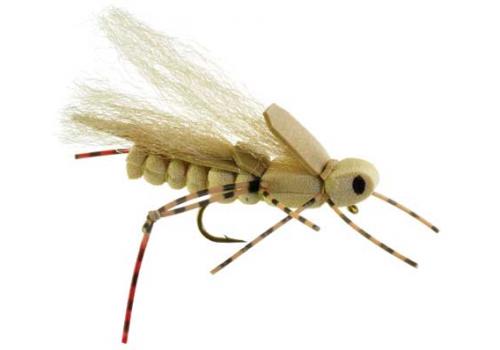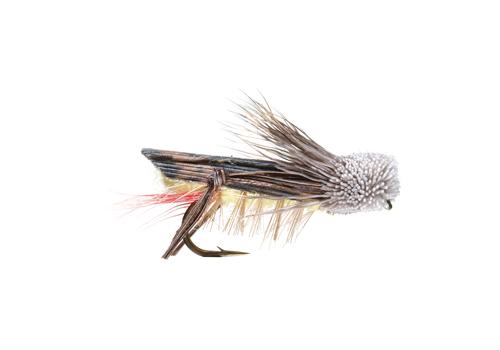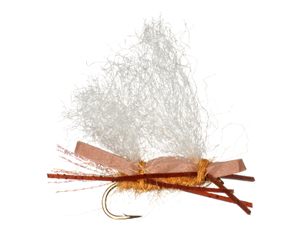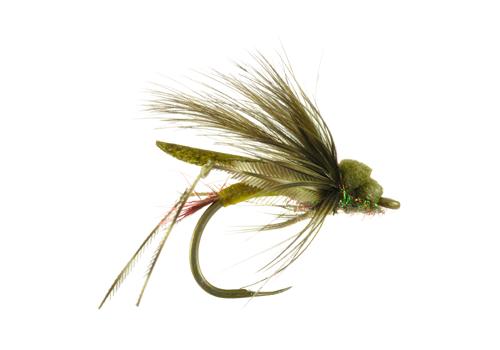I've always preferred fishing dry flies over all others, something  about this variety of fishing intrigues me. Maybe it's watching a trout slowly rise to a well presented fly, or how dry fly fishing allows the angler to enjoy the natural form of fly casting. Whatever the reason, surface flies are cool, and BIG surface flies are even cooler.
about this variety of fishing intrigues me. Maybe it's watching a trout slowly rise to a well presented fly, or how dry fly fishing allows the angler to enjoy the natural form of fly casting. Whatever the reason, surface flies are cool, and BIG surface flies are even cooler.
Hopper season also falls during one of my favorite times of year, late summer into early fall. The weather is normally ideal, not too hot but certainly not too cold. The rivers are all at prime levels, crowds are dissipating due to kids going back to school, and with natural insect hatches of summer starting to wane, trout are on the prowl for anything that will fill their bellies with minimal effort. Ah yes, the season of the hopper is upon us!
Hoppers also allow the angler to fish a multitude of rigs, in a variety of water, to a wide range of fish. Riffles, pocket water, deep runs and pools, they are all fair game and will likely hold fish looking to devour a big bushy dry fly on the surface. And because of their size, hoppers make ideal dry flies for shallow and deep dry/dropper rigs, and the now popular hopper/dropper/dropper rig. While not dry fly fishing in it's purist form, having flies both on and below the surface is a optimal way to find fish, and determine what they are feeding on.
There are a few things you need to keep in mind when preparing for hopper season, as the necessary gear will differ from what you are going to use with other methods of fishing.
The Fly Rod and Reel
Due to their large, air resistant nature, grass hopper patters require stouter rods to turn them over and get them to their intended destination. This doesn't mean that only fast action rods will do, as we are more concerned with the weight of the rod than the action. If you're fishing with a fast action fly rod (also called tip flex fly rods), any 8' 6" to 9' 4wt or 5wt rod will do. If we're talking medium fast action rods (also known as mid-flex rods), 9' 5wt or 6wt rods will suffice. Keep in mind with these softer rods that fishing in windy conditions will become more problematic.
The reel doesn't make any difference when playing the hopper game, but your fly line certainly does. Depending on the action of your fly rod, you'll want to have a good medium to heavy tapered fly line that will be able to turn over these larger dry flies. If you're fishing with medium fast action fly rods, look into medium tapered fly lines like Rio's Rio Gold, or Scientific Anglers Mastery Trout fly lines. If you're fishing with a fast action fly rod, any medium taper fly line will suffice, although heavier tapered fly lines like the Rio's Rio Grand or Scientific Anglers GPX will perform much better.
Leader and Tippet
You can put away your 6X and 7X, as bigger bugs will require stouter leader and tippet. I will normally fish a 7.5ft 4X leader with most hopper rigs, and if I plan on dropping a bead head nymph off the back, I'll normally resort to 5X tippet. I'm using these larger leaders as the wind resistant nature of hopper patterns will normally cause lighter leaders to twist. The shorter leader is more ideal for these larger flies, as it will help in turning them over more easily. That said, in situations where you're fishing larger rivers with longer drifts, you may want to resort to 9ft leaders for better presentation. This will require a more powerful rod though to help turn everything over.
Flies
Not much to say here, so I'll share a few of my personal favorites with you.
We've still got another 4-6 weeks of prime grass hopper season to go, so next time you're going to venture to your favorite fishing location, make sure your fly boxes are filled with a few of these big bugs.


 about this variety of fishing intrigues me. Maybe it's watching a trout slowly rise to a well presented fly, or how dry fly fishing allows the angler to enjoy the natural form of fly casting. Whatever the reason, surface flies are cool, and BIG surface flies are even cooler.
about this variety of fishing intrigues me. Maybe it's watching a trout slowly rise to a well presented fly, or how dry fly fishing allows the angler to enjoy the natural form of fly casting. Whatever the reason, surface flies are cool, and BIG surface flies are even cooler.




